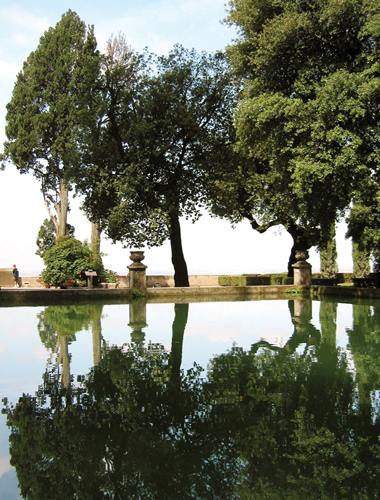Beyond the City Walls
The 3rd-century Aurelian walls are still largely intact and served as the defence of the city for 1,600 years until Italian Unification was achieved in 1870. After that, the walls were pierced in several places so that traffic could bypass the old gates and the modern city quickly sprawled far and wide in every direction. Although it’s undeniable that Rome’s most dazzling sights are contained within the walls, venturing outside them can have spectacular rewards. Ancient roads and even an entire ancient town, as well as some of Rome’s oldest churches, the mystical catacombs, and even Benito Mussolini’s pretentious contributions to modern architecture are all must-sees if you can draw yourself away from the city centre.
The Aurelian WallThis ancient wall was begun by Emperor Aurelian (AD 270–75) and completed by his successor Probus (AD 276–82). It stretches 18 km (11 miles) around the city, with 18 gates and 381 towers, enclosing all seven of Rome’s hills. In the 4th century, Emperor Maxentius raised it to almost twice its original height. To this day, most of the wall survives. |
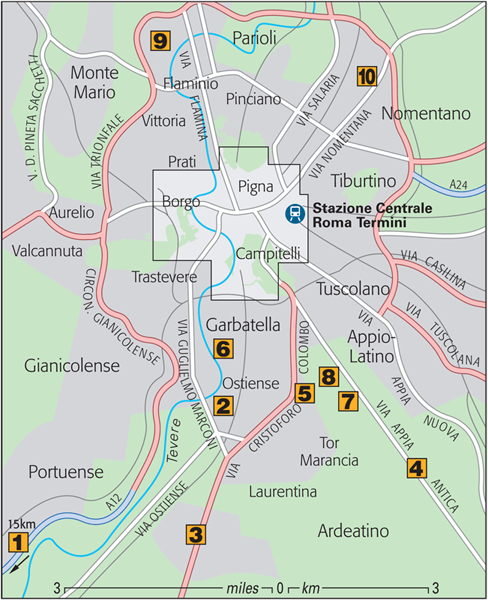
|
Sights
Ostia Antica
Ancient Rome’s trading heart has a wealth of fascinating ruins that evoke the city’s earliest days (see Ostia Antica).
San Paolo fuori le Mura
Rome’s second largest church has had a history of violent ups and downs. It was built by Constantine in the 4th century, over the spot where St Paul was buried, and for about 400 years it was the largest church in Europe, until it was sacked by the Saracens in 846. It was rebuilt and fortified, but its position outside the walls left it mostly ignored until the mid-11th century, when it underwent a renewal. Then came the 1823 fire, which led to the reworking we see today (see San Paolo fuori le Mura).
Via Ostiense 184
Metro Basilica S Paolo
Open 7am–7pm daily
Free
Apse mosaic, Sant’Agnese fuori le Mura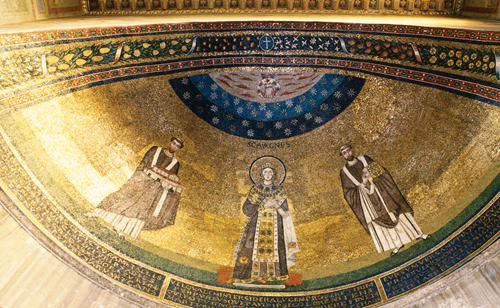
Façade, San Paolo fuori le Mura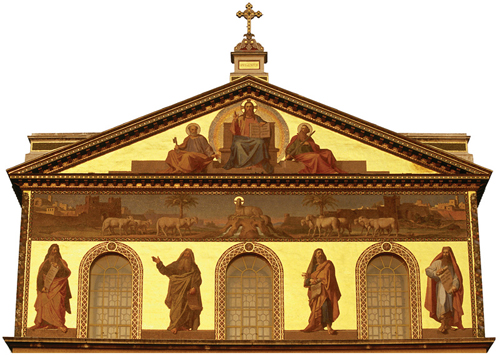
EUR
Built by Mussolini as a showcase to the world of the ideal Fascist metropolis, the EUR (l’Esposizione Universale di Roma) is disturbing to many visitors. The critic Robert Hughes described the so-called Square Colosseum as “the most frightening building in the world”, yet the aesthetic inspired many postwar architects. Aside from the hard-edged architecture, there’s a park with a lake, and a visit to the Museo della Civiltà Romana is instructive.
Metro EUR Palasport and EUR Fermi
Square Colosseum, EUR
Via Appia Antica
“The Queen of Roads” was completed in 312 BC by Appius Claudius, also the architect of Rome’s first aqueduct. The most pastoral part begins at the circular Tomb of Cecilia Metella, which was made into a fortification in the Middle Ages. Starting here, you’ll see more tombs and fragments of tombs, as well as grazing sheep and the private gates to fabulous modern-day villas. As you walk along, look to the east to see the arches of an ancient aqueduct marching towards the city (see Appia Way on a Sunday).
Buses 118, 218
Via Appia Antica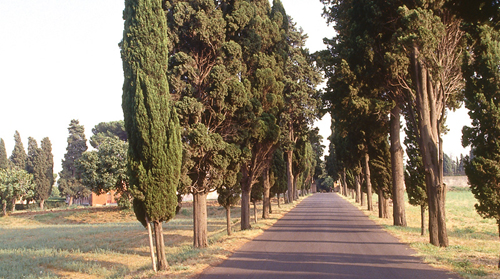
Catacombs of Domitilla
This is the largest catacomb network in Rome. Many of the tombs from the 1st and 2nd centuries have no Christian connection; burial of this sort was practised by several religious sects. The chambers have frescoes of both Classical and Christian scenes, including one of the earliest images of Christ as the Good Shepherd (see Exploring the Catacombs).
Via delle Sette Chiese 282
Buses 118, 218, 660, 760
Open Feb–Dec: 9am–noon, 2–5pm Wed–Mon (until 5:30pm in summer)
Adm €6.00
Rome’s very first power station has been transformed into a remarkable showcase for Greek and Roman statues – parts of the Musei Capitolini collection that, until now, were kept in storage. The effect is extraordinary, playing the monolithic might of modern technology off against the noble, human vulnerability of these ancient masterpieces.
Via Ostiense 106
Metro Piramide, Garbatella
Open 9am–7pm Tue–Sun
Adm
DA
Catacombs of San Sebastiano
Underground cemeteries outside the city walls were created in accordance with laws at the time, not a response to suppression (it was thought ghosts of the dead could interfere with the living). However, the remains of saints Peter and Paul may have been moved here, further away from the centre, during one of the city’s periods of persecution. There are also several 4th-century mausoleums, some with exquisite frescoes.
Via Appia Antica 136
Buses 118, 218
Open mid-Dec–mid-Nov: 9am–noon, 2–5pm Mon–Sat (until 5:30pm in summer)
Adm
Catacombs of San Callisto
Rome’s first official Christian cemetery, on four levels, features some rooms decorated with stucco and frescoes, and special crypts to early popes and saints that you can also visit. The rooms and connecting passageways were hewn out of relatively soft volcanic tufa. The niches, called loculi, were designed to hold two or three bodies.
Via Appia Antica 110
Buses 118, 218
Open Mar–28 Jan: 9am–noon, 2– 5pm Thu–Tue (until 5:30pm in summer)
Adm
Foro Italico and Stadio dei Marmi
Originally called the Foro Mussolini, the name was understandably changed in the late 1940s, even though the 16-m (55-ft) obelisk still shouts out “Mussolini Dux” (“Mussolini the Leader”). In imitation of every mad Roman emperor, there was even supposed to have been a 75-m (250-ft) statue of Il Duce posing as Hercules. The sculptures of the Stadio dei Marmi, 60 colossal nude young Fascist athletes, are worth a look.
Viale del Foro Italico
Bus 280

Sant’Agnese fuori le Mura and Santa Costanza
These 4th-century gems are located in the same Early Christian complex. Both are decorated with sublime mosaic work, the former depicting the martyred St Agnes as she appeared in a vision eight days after her death. The ambulatory around the circular Santa Costanza has truly delightful, richly detailed scenes of an ancient Roman grape harvest.
Via Nomentana 349
Buses 36, 60, 62, 84, 90
Open 7:30am–noon Mon–Sat, 4–7:30pm Tue–Sun
Free
DA
Santa Costanza
A Morning Walk on the Appia Antica
Start at the Porta San Sebastiano, the grandest city gate of them all, where you can visit the Museo delle Mura . Climb the stairs for great views. From here, continue straight on along the Via Appia Antica . One of the first sights you’ll come to, on the left at a crossroads, is the small church of Domine Quo Vadis? – this marks the spot where Peter, fleeing persecution, encountered Christ and decided to return to Rome and face his martyrdom like a saint. The church contains a replica of footprints in stone, said to be those of Christ, but it is actually an ancient pagan ex voto.
Quite a bit further ahead, you’ll come to the Catacombs of San Sebastiano. Take the guided tour, and don’t miss the curious fresco of a bowl of fruit and a partridge, which, according to some ancient writers, was the most lascivious of all creatures. Continuing on, past a mobile bar where you can buy snacks and drinks, visit the Circus of Maxentius, an ancient racetrack. Note how amphorae were embedded in the bricks to lighten the construction of the upper grandstands. Last stop will be the 1st-century BC Tomb of Cecilia Metella. The frieze of bulls’ skulls and garlands is beautiful and the cone-shaped sanctum is peaceful.
For lunch, walk back to the Ristorante l’Archeologia . After lunch, backtrack a few hundred metres to the bus stop to catch the No. 118 into town.
Daytrips from Rome
Hadrian’s Villa
Built as the emperor’s summer retreat between AD 118–134, the area was a vast open-air museum of reproductions of Hadrian’s favourite buildings.
Via Tiburtina, 6 km (4 miles) southwest of Tivoli
COTRAL bus from Ponte Mammolo
06 3996 7900
Open 9am–1hr before sunset daily
Adm
DA
Mosaic pavement, Hadrian’s Villa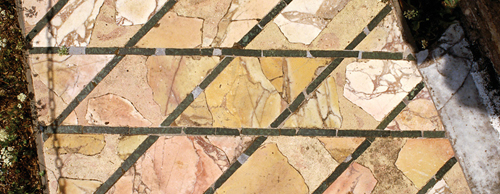
Ionic columns, Hadrian’s Villa
Tarquinia
A museum of Etruscan artifacts famous for its 4th-century BC terracotta horses.
Train from Termini or Ostiense or COTRAL bus from Lepanto
07 6685 6036
Open 8:30am–1 hr before sunset Tue–Sun
Adm
Castelli Romani
There is much to attract in this area of the Alban Hills. Swim in Lago di Albano, or visit Palazzo Chigi in Ariccia, a Baroque complex designed by Bernini in the 17th century.
Metro Anagnina, then COTRAL buses
Palazzo Chigi
06 933 0053
Open 10am–7pm daily – tours at 11am, 4pm, 5:30pm Mon–Fri & all day on weekends (gardens open Apr–Sep)
Adm
Frascati
From the 16th-century Villa Aldobrandini you can take in magnificent panoramas of Rome.
Metro Anagnina, then COTRAL bus
Villa Aldobrandini
06 678 7864
Open 9am–1pm, 3–6pm Mon–Fri (until 5pm in winter)
Palestrina
This town boasts the greatest Hellenistic temple in Italy. Among the treasures unearthed here is a 2nd-century BC mosaic.
Metro Anagnina, then COTRAL bus
Museum: Open 9am–7pm daily, Adm
Rome’s Beaches
The Ostia sea strip to the city’s south is dotted with beach clubs and free beaches (spiaggia libera).
Trains depart from Porta San Paolo; ATAC bus or metro ticket required.
Viterbo
Within this medieval town’s walls, visit the Papal Palace, the Archaeological Museum and the Fontana Grande.
Most sights: Open 8:30am–7pm Tue–Sat,
Adm
Pompeii
In AD 79 the volcano Vesuvius erupted, and this city was buried and preserved forever.
Train from Termini to Naples, then “Circumvesuviana” train
Open 9am–1.5hrs before sunset daily
Adm
DA
Places to Eat
Allo Sbarco di Enea, Ostia Antica
Kitsch, but fun. The waiters dress up in Roman gear and the decor is like a low-budget epic movie. The speciality is fish try the spaghetti alle vongole (clams).
Via dei Romagnoli 675
Metro Piramide then local train
06 565 0034
Closed Mon
Jet Set, EUR
A pleasant surprise in rather flavourless EUR. Huge picture windows right on the lake make lunch a visual treat. The menu offers light fare and the fish dishes are nicely presented.
Piazza U. E. Terracini
Metro EUR Palasport
06 591 3743
Closed Sun L
Ristorante l’Archeologia, Via Appia Antica
An elegant converted farmhouse, where you dine around the fireplace in winter and in the garden in summer. Rustic regional fare, such as roast lamb and homemade pasta.
Via Appia Antica 139
Bus 118
06 788 0494
Closed Tue
La Villetta dal 1940, Piramide
The favourite hangout of 20th-century Surrealist painter Giorgio De Chirico and his crowd of passionately avant-garde artists. The food is hearty and traditional Roman fare, such as saltimbocca alla romana (veal and ham).
Viale della Piramide Cestia 53
Buses 23, 30, 75, 95, 280, 716, 719
06 575 0597
Arancia Blu
A seasonably varied menu, which includes exquisite desserts, sets this vegetarian restaurant apart.
Via Prenestina 396a
06 445 4105
Closed for L
La Sibilla, Tivoli
The most spectacular spot in town, overlooking Villa Gregoriana.
Via della Sibilla 50
COTRAL bus from Ponte Mammolo
0774 335 281
Closed Mon
San Marco, Tarquinia
An old converted monastery. Game and funghi selvaggi (wild mushrooms) in season are good.
Piazza Cavour 18
Train from Termini or Ostiense or COTRAL bus from Cornelia
0766 842 234
Closed Mon L
Pinocchio, Frascati
Pinocchio (also a hotel) specializes, as does this entire area, in the celebrated porchetta (pork roast).
Piazza del Mercato 21
Metro Anagnina, then COTRAL bus
06 941 7883
Closed Tue L
Scylla, Sperlonga
On the beach and great for seafood.
Via San Rocco 26
Train from Termini to Fondi, then bus
0771 549 652
Closed Tue (winter)
Enoteca La Torre, Viterbo
This bar-restaurant offers local dishes, with an emphasis on fish. Great wines too.
Via della Torre 5
COTRAL bus from Saxa Rubra or train from Roma Ostiense
0 761 226 467
Closed Mon, Tue, Wed L
|


